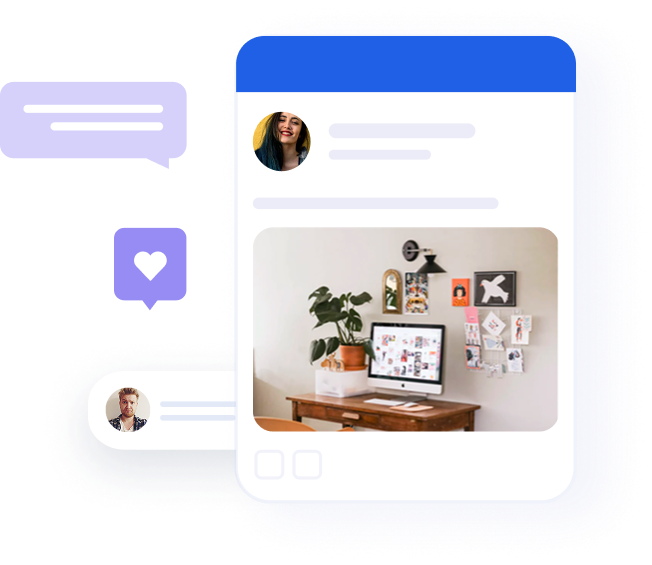Social recruiting: 6 tactics to master for better ROI
Table of contents
Recruitment practices have undergone a major change in the last couple of years. Social recruiting has become increasingly popular, and in recent years, it has taken center stage, especially for industries with high competition over talent, like tech.
Marketers and HR have both been tasked with creating and boosting employer branding on social media and leveraging this branding for social recruitment. But which social recruiting tactics will get your the best results? And what constitutes as social recruiting, anyway?
What is social recruiting?
Social recruiting is the practice of recruiting employees on social media.
One of the most popular social recruiting practices is finding and reaching out to qualified candidates on LinkedIn, but there are many other ways to engage in social recruiting. Building a robust employer brand on social media is one of them, by sharing HR- related content. Employee advocacy is also an effective technique used by companies to recruit talent.
What are the best ways to get results from social recruiting?
There is no doubt that social recruiting is gaining ground for a good reason. 30% of social job seekers earned over $100K a year, while 43% of them had higher education. This makes social networks the go-to platforms for recruiting educated, skilled employees.
But how you do get results with social recruiting?
1. Know your audience
To be successful at social recruiting, you need to understand where your qualified candidates are and how you should approach them.
If engineers are the talent your company is looking for, the best place to find a community of developers and coders would be GitHub. If it’s designers you’re seeking, LinkedIn is a good bet, being a social network for professionals, but Instagram or even Pinterest could yield a higher ROI, seeing as those social networks would be a natural draw for designers.
Adjusting your strategy to each social network is also important. LinkedIn is where you go to share and gain professional knowledge, so it’s only natural for a recruiter to send a message to a potential candidate on LinkedIn and see if they’d be interested in a position. Instagram, on the other hand, would be more suited for “softer” social recruiting techniques, such as posting job openings, team photos and reflecting company values through images and quotes.
This is a good example from Marketo’s Instagram page:

Understanding where your candidates expect to be approached and what the best way to approach them is will help you do social recruiting more effectively.
2. Do your research
Before reaching out to candidates on social networks, determine the profile of your ideal employee. You will need to consider their experience, education, skill set, and any other relevant characteristics. Blasting bulk InMails at LinkedIn users without examining their profile first will not only be counter-effective, but it can also generate annoyance and criticism toward your brand on social media.
Your research should also include more granular insights. Try to understand what candidates consider to be valuable when picking a new workplace. Are they looking to learn new skills, or maybe they’re interested in the unique benefits that your company offers? One of the ways to uncover those insights would be social listening, while other ways include surveying your current employees or candidates.
Arming yourself with this research will allow you to target candidates on social media better and see more success with social recruiting.
3. Invest in employer branding
Like you’re using social media to research, so are your candidates. In fact, 59% of candidates use social media to research companies they’re interested in.
The social recruiting process often doesn’t start and end with recruiters reaching out to candidates. Candidates will do their research on the company’s social media profiles well before they’ve been approached or after the initial email from the company, to see if they’re interested in pursuing a career opportunity in the organization.
This is why employer branding is a vital part of social recruiting. Sharing HR-related content on social media is paramount to social recruiting. Make sure candidates are able to discover your company culture, the value you provide to employees and all the reasons why your people LOVE working for your company.
HubSpot provides a good example of employer branding on social media:

Highlight employee interviews, career stories, team photos, company events and stories about your vision and values as a company. Leveraging employer branding as your stepping stone, your social recruiting will get the boost it needs to reach the best talent and convert it into candidates.
4. Recruit your existing employees
Your employees are a perfect reflection of your company as a workplace. If they’re happy, they will show it in every possible way, including on social media. They will share photos celebrating their professional success or just an image of them with their colleagues at a fun company event.
Regardless of the content, their social media messages will be perceived as more authentic than those of the corporate profiles, and they will also be trusted much more by their peers. But positive employer branding isn’t the only reason to encourage employee advocacy on social media.
Referrals are a major part of any company’s recruitment strategy. In fact, 82% of employers rated employee referrals above all other sources for generating the best ROI.
Employee advocacy allows employers to tap into referral recruitment in the most effective way. Employees who share job openings or even general company content will be able to extend the company’s reach to a new, extensive pool of talent and position the company as a good employer.
To help them do that and encourage consistent sharing, adopt and employee advocacy technology that is able to boost employee engagement but also provide in-depth analytics into the performance of advocacy, like Oktopost’s employee advocacy platform.
5. Transparency is the name of the game
Put transparency high on your list of priorities when engaging in social recruiting.
If you’re reaching out to a candidate, you need to be very clear on who you are, which company you’re working for, and which position you’re recruiting for. Lack of transparency is liable to generate lack of trust among the professionals you reach out to and eventually- lead to the failure of your social recruitment efforts.
In some rare cases, such as recruiting for a very senior position, HR managers will choose not to reveal all the details at first, but this applies mainly to executive recruitment. Candidates understand this nuance and expect to get the full details about a position if they’re being approached on social media.
6. Create an awesome candidate experience
Just because it’s social media doesn’t mean the candidate experience should be any different to the one you’re creating for professionals recruited through an agency or an employee referral.
Candidates expect not only transparency, as mentioned earlier, but also consistency and professionalism. Make sure you’re not making promises you cannot keep when recruiting on social media. If after an initial process a candidate turned out not to be a good fit, take the time to get back to them and let them know.
A candidate experience for professionals coming in through social recruiting should reflect your company’s recruitment processes and leave a good impression. Remember that Glassdoor is only a click away, and frustrated candidates can take to social media to vent their anger at a bad recruitment experience.
Personalization plays a big part in creating an awesome candidate experience. Invest time in researching the profile of the professional you’re targeting and leverage your insights to create a personal message for them. For example, you can mention their previous experience as being valuable to the role you’re hiring for. Candidates will appreciate and respond better to a personalized email than to a generic one.
As with everything in marketing, personalization creates better engagement, and engagement is key when trying to seek out talent in a competitive job market.
Recommended for further reading
Boost your social recruiting by turning employees into brand advocates
With social recruiting getting more and more traction, your potential employees will actually be expecting to be recruited using social media. To maximize your efforts, invest time in doing sufficient research, adjust your efforts to fit different candidates, and don’t lose sight of the need to be transparent.
To boost your social recruiting efforts, tap into the potential of your employees’ networks via employee advocacy. Have a look at this guide we created, which details all the ways employees can turn into top advocates – and share it with your colleagues to harness them into the recruitment process.




